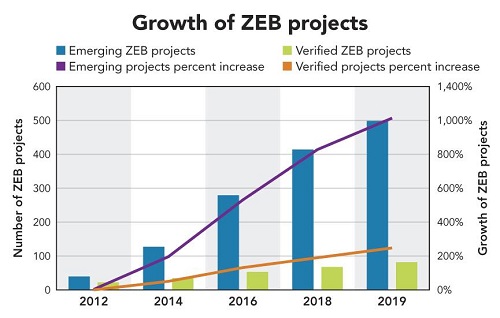 Thursday, April 25, 2024
Thursday, April 25, 2024  Thursday, April 25, 2024
Thursday, April 25, 2024 
When researching building energy efficiency, renewable energy and the electrical grid, industry publications and academic journals will invariably have articles and papers on zero energy buildings and the smart grid.
To eliminate any discrepancies in terminology that may occur in the different publications, we need to use common terminology for ZEB and smart grid. For example, different organizations use nomenclature for ZEB such as zero net energy, net zero energy, net zero, etc. The legacy definitions are not necessarily incorrect; rather they reflect the rapid refinement of technical definitions and nomenclature over the past several years.
To rectify these differences, in 2015 the National Institute of Building Sciences prepared a study titled, “A Common Definition of Zero Energy Buildings” for the U.S. Department of Energy:
“In 2014, the U.S. DOE Building Technologies Office contracted with the National Institute of Building Sciences to establish definitions, associated nomenclature and measurement guidelines for zero energy buildings, with the goal of achieving widespread adoption and use by the building industry.”
Similarly, while smart grid is a widely used term, standards are still in development. Because smart grid is a long-range, phased implementation that may mean different things to different constituents, it is not surprising that standards and nomenclature are in a state of flux. But for the purposes of this article, the definition of smart grid is based on the high-level National Institute of Standards and Testing definition:
“… a modernized grid that enables bidirectional flows of energy and uses two-way communication and control capabilities that will lead to an array of new functionalities and applications.”
In the past decade, much progress has been made regarding ZEB, and not just research and analysis; many buildings have been designed, built and are operational. The operational facilities offer the opportunity for measurement and monitoring, which is invaluable for the design and construction of future buildings.
As building codes in the United States slowly move toward a requirement for all new building projects to be designed and built in compliance to ZEB standards, the operational data from the facilities will become essential to inform the code officials.
For example, California Title 24 updates , which went into effect January 2020, require all new single-family homes and low-rise apartment buildings to install solar panels to compensate for all electricity used by the building. Also, in 2018 The United States Conference of Mayors passed resolutions that support net-zero building construction by 2050.
Some municipalities require building construction to be “zero energy ready” meaning that the building can be built and operate without the renewable energy component and renewable energy can be added later without significant changes to the building infrastructure.